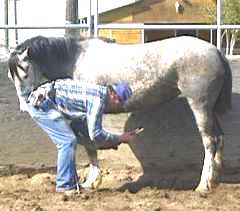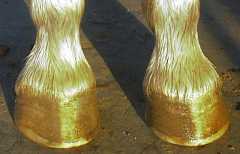|
We thought these horses would be our most challenging subjects, however they were by far the easiest. We were concerned with the effects of radical changes to foot angles when a proper trim was applied and the length of time it would take before the overgrown and distorted hoof could be brought into balance using a 4 point trim.
The approach I took was to focus primarily on overgrown hoof wall on the first trim, cutting back horizontally the overgrown toe and excess sidewalls. The horses were left basically walking on their bars and toe callouses and only minor corrections were made to the sole plane in order for the hoof to strike the ground level and slightly heel first.
To my amazement, when I checked the feet about 2 weeks later, the excess sole had either exfoliated on its own or could easily be peeled out, revealing a very healthy sole and a virtually perfect plane to trim to. Thus within 2 to 3 weeks, these horses went from severely overgrown to level and never exhibited any signs of soreness.
|
Taking off grossly overgrown toes

Front feet after second trim

|